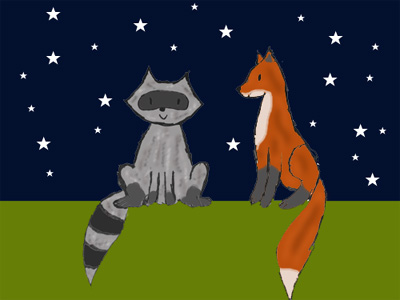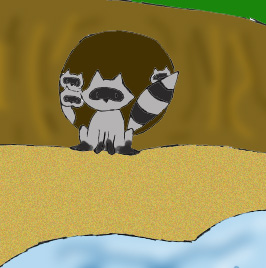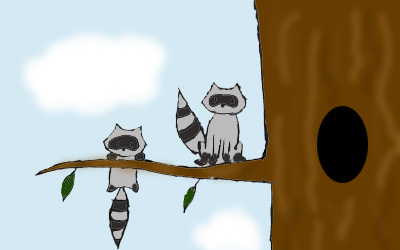Introduction
The Adventures of Rusty the Raccoon

Procyonidae. © 2006 racoon1
Rusty’s mom taught her kits many important things. She taught them how to climb trees, catch fish, and swim in the river near their den. She also taught them what food they could eat and where they could find it. The little raccoon kits hunted for frogs and other amphibians, and foraged for edible plants. Rusty’s mom taught her kits that they could eat just about everything, including scraps of food they found in the garbage cans of the humans who lived in the city by the river. However, Rusty and her siblings were warned that humans did not like raccoons, and that other animals who lived near humans could bite raccoons and make them sick. Because of this, Rusty was always very careful.
In the summer, Rusty and her siblings played near their den. They climbed trees, chased each other, and swam in the river. However, after a while, Rusty realized that the leaves were changing colour, and that it was becoming colder outside. “Mom, what’s going on?” she asked, perplexed. Her mom replied that it was fall, and soon it would be winter. “What do raccoons do in the winter, mom?” asked Rusty.
“ In the winter, it is cold, and difficult to find food. If the winter turns out to be very cold, and it is too difficult to find food, then we will sleep through the winter in our den,” replied Rusty’s mom.
That winter it was very cold, and Rusty’s family hibernated together in their den.
In the springtime, Rusty and her brothers and sisters were finally grown up, and ready to leave their mom. They said goodbye, and headed out to find burrows and dens of their own.
Rusty found an abandoned burrow, by the banks of the same river where she had grown up. Though she had a home of her own, Rusty was very lonely. She missed her mom and her siblings. Now that she was on her own, she had nobody to play with and talk to.
One day, when Rusty was foraging in a garbage can for food, she saw another animal. It was fluffy and red, and confused-looking. Rusty had never seen an animal like this, and because it looked lost, she wanted to help it.
“Hello!” she said, approaching the strange new animal. “What’s your name? What are you?” they asked each other at the same time.
“My name’s Zorro. I’m a red fox… and what are you?” asked the fluffy red creature.
“I’m Rusty the raccoon,” she replied, “Where are you from? I’ve never seen you here before.”
“I am from Canada. I’m a Canadian fox.”
“ I have family in Canada” said Rusty happily.
" I have family in the United States” said Zorro.
“Do you want to be my friend?” they asked each other at the same time.
Now, Rusty had a friend, Zorro the fox. They did everything together. She wasn’t lonely anymore.


Procyonidae. © 2006 racoon1
Summary: While reading this treehouse students will learn some basic facts about raccoons including their general habitat, their dietary habits, their range, their appearance, and about various traits and skills these mammals have. Students will also learn a little about a raccoon's reproductive cycle, as well as the dangers raccoons face when living in close proximity to humans.
Information on the Internet
- Kness Raccoon Facts This site has good general information about raccoons, including general size, habitat, and special skills.
- Animal Facts- Raccoon This page is arranged in an easy-to-read format, and it contains general information about raccoons, and a map of their range. Also, it contains links to other useful websites about raccoons.
- Raccoons and Rabies: Statistics and Facts This website, created by Canadian Geographic, contains very reliable general information about raccoons.





 Go to quick links
Go to quick search
Go to navigation for this section of the ToL site
Go to detailed links for the ToL site
Go to quick links
Go to quick search
Go to navigation for this section of the ToL site
Go to detailed links for the ToL site